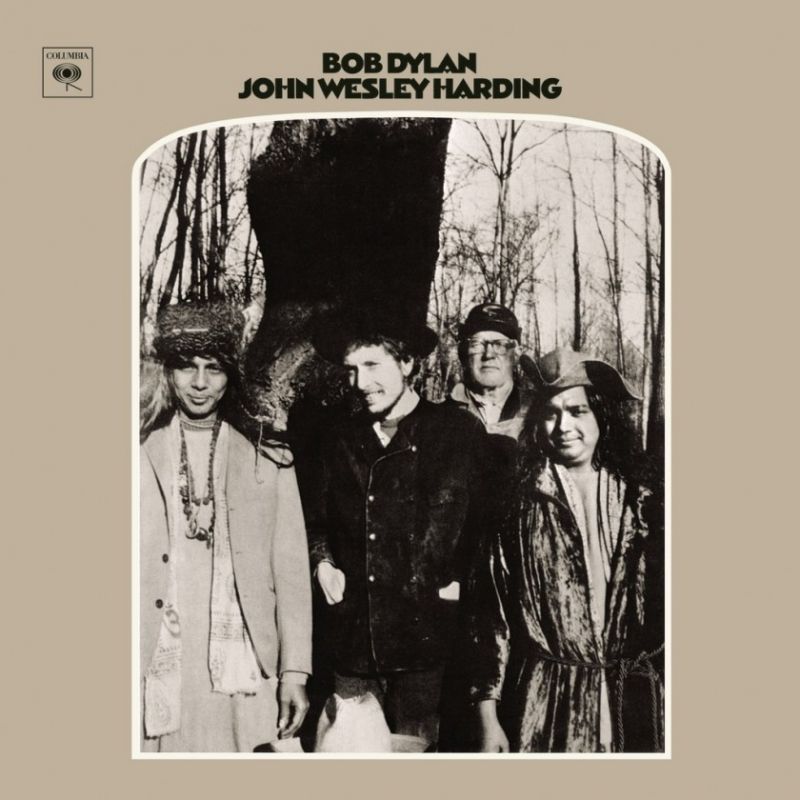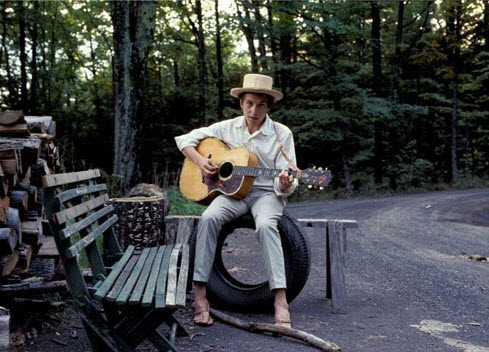
[vc_row][vc_column][vc_message message_box_color=”mulled_wine” icon_fontawesome=”fa fa-quote-left”]I heard the sound that Gordon Lightfoot was getting, with Charlie McCoy and Kenny Buttrey. I’d used Charlie and Kenny both before, and I figured if he could get that sound, I could…. but we couldn’t get it. (Laughs) It was an attempt to get it, but it didn’t come off. We got a different sound… I don’t know what you’d call that… It’s a muffled sound.
~Bob Dylan to Jann Wenner November 29, 1969[/vc_message][/vc_column][/vc_row]
52 years ago today Bob Dylan started recording “John Wesley Harding”.
Some background from wikipedia:
Dylan went to work on John Wesley Harding in the fall of 1967. By then, 18 months had passed since the completion of Blonde on Blonde. After recovering from the worst of the results of his motorcycle accident, Dylan spent a substantial amount of time recording the informal basement sessions at West Saugerties, New York; little was heard from him throughout 1967. During that time, he stockpiled a large number of recordings, including many new compositions. He eventually submitted nearly all of them for copyright, but declined to include any of them in his next studio release (Dylan would not release any of those recordings to the commercial market until 1975’s The Basement Tapes; and by then, some of those recordings had been bootlegged, usually sourced from an easy-to-find set of publisher’s demos). Instead, Dylan used a different set of songs for John Wesley Harding.
It is not clear when these songs were actually written, but none of them has turned up in the dozens of basement recordings that have since surfaced. According to Robbie Robertson, “As I recall it was just on a kind of whim that Bob went down to Nashville. And there, with just a couple of guys, he put those songs down on tape.”
Those sessions took place in the autumn of 1967, requiring less than twelve hours over three stints in the studio.
Dylan brought to Nashville a set of songs similar to the feverish yet pithy compositions that came out of the Basement Tapes sessions. They would be given an austere sound sympathetic to their content. When Dylan arrived in Nashville, producer Bob Johnston:
“he was staying in the Ramada Inn down there, and he played me his songs and he suggested we just use bass and guitar and drums on the record. I said fine, but also suggested we add a steel guitar, which is how Pete Drake came to be on that record.”
Dylan was once again recording with a band, but the instrumentation was very sparse. During most of the recording, the rhythm section of drummer Kenneth A. Buttrey and bassist Charlie McCoy were the only ones supporting Dylan, who handled all harmonica, guitar, piano, and vocal parts.
“I didn’t intentionally come out with some kind of mellow sound……. I would have liked … more steel guitar, more piano. More music … I didn’t sit down and plan that sound.”
~Bob Dylan 1971
The first session, held on October 17 at Columbia’s Studio A, lasted only three hours, with Dylan recording master takes of “I Dreamed I Saw St. Augustine”, “Drifter’s Escape”, and “The Ballad of Frankie Lee and Judas Priest”.
Studio A
Columbia Recording Studios
Nashville, Tennessee
October 17, 1967, 9 pm – 12 midnight.
Produced by Bob Johnston
Songs:
- Drifter’s Escape
- Drifter’s Escape – JWH

“Dylan once again demonstrated his distaste for the legal process, preferring to leave Judgment to Him on high. Reversing “Percy’s Song” and “Seven Curses,” he makes the judge compassionate but powerless. He also sets the drifter free, not at the whim of the judge, but via that most traditional of devices, the deus ex machina. A bolt of lightning causes everyone else to pray, allowing the (presumably faithless) drifter to escape.
Dylan had found a way to tell a five-act story in just three verses.
Enthused by what he had achieved, he began writing a whole set of
songs along similar lines.”
~Clinton Heylin (Revolution in the Air) –
- Drifter’s Escape
- Drifter’s Escape
- Drifter’s Escape
- I Dreamed I Saw St. Augustine
- I Dreamed I Saw St. Augustine
- I Dreamed I Saw St. Augustine
- I Dreamed I Saw St. Augustine – JWH
The song .. is a work of art, extremely moving, totally original.
~Paul Williams (Performing Artist – 60-73)
–
Not only is “St. Augustine” a eulogy of sorts, it is exquisitely sung
(even if Dylan and his fellow Americans don’t know how to pronounce the saint’s name, rhyming it with “mean,” not “sin”).
~Clinton Heylin (Revolution in the air)
–
- The Ballad Of Frankie Lee And Judas Priest – JWH
Unusually for a Dylan song, “The Ballad of Frankie Lee and Judas Priest” ends with a moral, telling the listener “the moral of this story, the moral of this song, is simply that one should never be where one does not belong”, to help one’s neighbor with his load, and “don’t go mistaking Paradise/for that home across the road.
(from wikipedia – read more here)
–
Personnel:
- Bob Dylan (vocal, guitar & harmonica),
- Charlie McCoy (bass),
- Kenneth Buttrey (drums).
Notes:
- 3, 4 are false starts.
- 6 is interrupted
- Only released tracks are in circulation.
–
Related articles @ alldylan:
References:
- Bob Dylan: The Recording Sessions – Part Two – by Michael Krogsgaard
- Still On The Road – Olof Björner
-Egil




Why won’t you post “He’s Only a Pawn In Their Game”?
Not so much ahead of its time as more of a side road that would vanish into the desert. A mythical and mystical soberness that would grind to a halt later in too much simplicity, but at that moment it arrested us in our craze, and yes it pointed to the search for someting new that would come from the roots, and in that it was futuristic, a masterpiece. But as I said, it would also prove to become a suffocating formula, that method of three simple verses, whereas the freedom of the absurd lyrics from The Basement might have been a better way to go. Still glad he made this one. The only thing I reaaly would like to question is, did Rosen reject the tapes he made with The Band, or was it Dylan himself who did not see them fit for publication. I have this slight notion, and read about it somewhere, that he was pissed of that they did not want to make an album out of it… (?)
And yes, keep up the good work!
Thanks Hans for (as always) an interesting comment.
It’s another “brown” album….it’s the BLONDE ON BLONDE band, without everyone but Buttrey and Daniels (and the cameo buy a Pete Drake). I remember the first spin…I cannot describe that feeling in words….I felt he was tapping into the supernatural via simplicity and inner vision…so simple, the songs are vastly complex….”…visions in the final end…” ~E
J W H was released about the same time as Sgt.Pepper’s ( Beatles ) and Their Satanic Majesties Request ( Rolling Stones ) …. what a richness in contrast, those were the days ! Retrospectively, I think Dylan had more guts to risk his new ( retro ) style than the others because he was simply ahead of the times, as usual.
Thanks for the response, Egil. Wonderful site and keep up the good work!
Thanks AWFF,
This website (or blog).. whatever.. will keep on producing stuff to our taste in music.. “forever”…
-Egil (after 8 pints..more to come..)
Sure he’s entertaining, but Heylin’s work is often speculative and misleading. Notice how Gray, Williams, Marcus and others simply illuminate the man’s work with their own perceptive analysis. Heylin is desperate to be the authority on Dylan and compensates for a lack of insight by marshaling facts and making nebulous links that often don’t hold up. I guess that would be my take: speculative rather than authoritative.
Hi Again AWFF,
I really appreciate your (well written) opinion.
“…marshaling facts and making nebulous links that often don’t hold up.” .. nice! That’s Heylin 🙂
But “often” or “sometimes” … could be discussed, guess I’m leaning towards “sometimes”.
BTW Angelina is a fantastic song.. I dig Gray’s take on the lyrics in “Song & Dance Man 3”.
-Egil
Clinton Heylin might come of abit opinionated and we understand that he can “piss people off”, but we like his “arrogant” tone, and never read him or quote him without a critical eye. If possible we check facts with more than one source. He is entertaining, very quoteable and I think he is very knowledgeable, I don’t aggree that he jumbles facts together. He has a certain style that is not to everyone’s taste, but as I said, I like his writings.
…but it was Egil who wrote this post, and he maybe has some other views on the subject.
Thanks for the feedback.
– Hallgeir
Thanks for the Feedback AWFF!
I support Hallgeir…
I know he’s not right all the time..(although I doubt he’d admit it ;-)) and sure has a way about always trying to sound clever..
BUT he’s great fun.. & “know’s his Dylan”.
I always try to quote the master himself as much as possible.. and will continue to do so.
But I also like to use M.Gray, P.Williams & C.Heylin… as I consider them to be 3 of the greatest “Dylan writers”.
-Egil
I totally agree with your view on Mr Heylin’s approach to Dylan. His biography, Behind the Shades, gives a splendid, precise and efficient (not too long) overview of Bob Dylan’s life. And him being opinionated – it defies me how one can be an avid fan of Dylan’s work without being opinionated!
Great read, an odd album in many ways, Bob seizing the moment, but a mysterious moment it was.
I would be careful to quote Clinton Heylin, he’s prone to making definitive pronouncements that may or not be true – a mind reader shall we say. A rabid fan once upon a time, but more of a compiler of (sometimes incorrect) facts who jumbles them together and tries to sound clever, but not much illumination there.